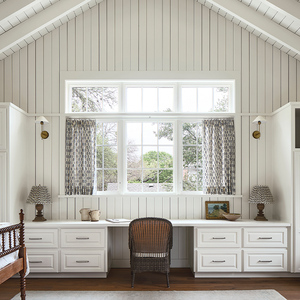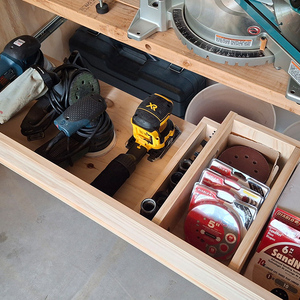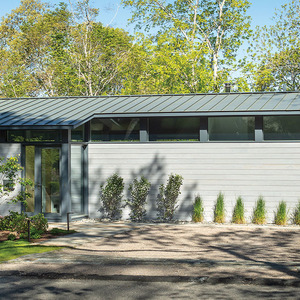Does anyone have, inhand or on resource, formulae to calculate uniform and point load capacities of cantilever joist?
The normal rule of thumb doesn’t make me comfortable with the needed application in an abnormal situation.
Thanks……………………………Iron Helix
ps…………….how about a “general standard” uniform load factor number for stucco coated straw bale wall construction?



















Replies
I cantilever about 1/4 of the toal length. Never had a problem. I hear you can go even further but I'm not comfortable with that. A 12' length you should be able to cantilever about 3'. Depends what youre doing..... a deck? A whole two story house on the eave side.....gable side??????? If its more then a deck I'd consult an engineer.
Be well
Namaste'
Andy
It's not who's right, it's who's left ~ http://CLIFFORDRENOVATIONS.COM
Don't know the formulas, other than the most basic stuff. Like a 3' cantilever with 1,000# at the end of it would have a 3,000 ft.# bending moment. (3' X 1,000#)
But there are a bunch of other things to consider. Like back spans, uplift connections, alternate load cases, deflection, and shear to name a few.
I hate tossing that "you need an engineer" phrase around too much, but that may be the case here. Find one friendly enough and maybe he'll teach you the formulas involved.
I'm writing a book. I've got the page numbers done, so now I just have to fill in the rest.
About 2 or 3 years ago one of the mags had an article on this. I believe that it was JLC, but it might have been FHB.
JLC sell individual articles online for $5 (I think) if you don't have the issue.
I wouldn't cantilever ANYTHING more than 3 feet. I don't care how long the piece of material is that is being cantilevered.
Iron Helix,
One question...what load is the cantilever supporting at the end of the cantilever?
A minor point, but...<g>
Typically, a cantilever that is not carrying significant roof load or more than one floor load can be cantilevered a third of the length of the joist. A 12' joist, cantilever it 4'. That's a maximum. As Andy mentioned, being conservative will give you better performance.
Cantilevering a first floor platform in a 2-story house...that varies. At least it's varied in the last three places that I lived. One place limited it to a straight 24" maximum cantilever. Another limited it to the depth of the floor joist being cantilevered, another limited it to twice the depth of the floor joist begin cantilevered.
If you got the plans approved by an engineer, the above limits did not apply.
Define the load, and that will define the amount of allowable cantilever. If it's in no-man's land...go see The Man to get your plans stamped.
rules of thumb.......2 to 1 rule......in 2 for every 1 out.....unloaded
loaded.......twice the depth of the joist.
so anyting more than a little sitting deck should be engineered and supported. Jeff She's exotic ,but not foreign, like an old Cadillac......she's a knockout!
Recommend that you be very careful here. In timber construction, factors which affect performance of the product include bending moment, shear, deflection, and creep. The placement and type of load determines the factors. For simple framing of insignificant loads, 1/3 rd the span for sizes of 2 x 10 and above will work, not to exceed 4 feet. For significant framing, consult an engineer. Use treated lumber for all exterior applications.
It seems that we are all in about the same place.....need to see "the Man" as Mongo aptly puts it!!
Phil is pushing toward the needed aspect of the problem.....specific technical data, which I have, but nowhere to plug it in for a generated answer.
Looks like it will be a $$$$ formula if I can find a talkative resource. I'll share it when I find it.
.....................................................Iron Helix
IH,
May I strongly suggest that you not try to plug data into formulas unless you are knowledgeable in the subject. It's not that easy. You need to know how to analyze the problem.I'm sure that you realize the risk.
Lets us know how you make out.
Thanks for your concern......they are mine also. I have had experience over the years using formulas for sizing construction applications....but this is the first time to run into the need to calculate cantilever capacity as opposed to "rule of thumb" or use of a mfg.spec. sheet on cantilevers
I don't think there is a problem with overload....the cant is only 18" on 2x10-14 #1 kd syp @ 16"oc and the roof load is not sent to the cantilever. My concern is my client wants to use stucco coated straw bales as the 19' tall exterior wall set outside the timber framed structure on this 18"cant. How many pounds of uniform load will this cant floor system have, and what will the deflection be?
If the water becomes too murky.............I'll head for the beach and send my client to find an engineer. (Not many to be had in our rural area)
Thanks to every one.......................Iron Helix
Jeff is correct in the fact that the properties govern the performance and capabilities of the material. I could have given you the formulas, but that is dangerous, since you may not know how to determine the properties and use the formulas correctly. Suggest that the owner hire an engineer. Not a difficult or costly process, but well worth it.
Found a book...American Institute of Steel Construction and a a set of 11 specific formulas addressing "Beam overhanging one support-concentrated load at end of overhang". Terms in formula are same or similar to those used in wood structure....but are the formulae translatable from steel to wood?
So do I hire a translator or buy an engineer ???????????????
The water is very muddy either way..................time to pay the piper. Results will follow when I return from a trip after 07/04 and try to find an engineer.
Thanks again for the discussions and advice........................Iron Helix
The beam formulas in the steel manual are standard beam bending, shear, reaction and deflection formula for typical load cases. They do not relate to the framing material. That is handled by the other side of design, through the allowable stresses, which are directly related to the material properties....that's not a mistake, it's rustic
Iron,
Well, here's the formula :
Fb = F*L/S*12 psi. F is the force, L is the length, S is A^2 *B/6. for a 2x10, A is 9.25 and B is 1.5. For #2Hemfir the maximum allowed Fb (fiber bending stregnth) is 1075 psi. There are a few other factors such as load duration factor, moisture when built, etc, which will raise or lower this value by 10 or 20% or so, but that's the general formula if you want to play with it.
Darrell Hambley, PE
I had a course on these types of calculations a year or so ago and the class book is a good source of formulas for solving problems like yours.
Basic Engineering Calculations for Contractors by August W Domel, Jr Published by McGraw-Hill. Cost $35
Sorry for the delay in reply.........I went south to marry off #2 child, and when I returned 12 days later the computer would not compute.
The hard drive was blown.......new one installed today under warranty. Now to resurrect the lost files that had not been saved to a back-up, plus play catch-up.
Lou & Darrell thanks for the information......we will see where this takes me.
And thanks "to all" for the input and discussions............................Iron Helix
Now to resurrect the lost files that had not been saved to a back-up
If you find a good voodoo doctor to do this, be careful not to sell him your soul!
LOL
Excellence is its own reward!
Actually there are data recovery companies that will do this. Depending on the problem it can be cheap or very expensive.
Often the fail is in the electronics on the drive and they just swap then and run the drive.
In other cases that have to get to the actual disk and run it in a clean room with equipment that the even the CIA doesn't have. Looking at each flux transistion and try to figure it all out.
Came in on this one late, but agree strongly (but no caps) with Phill that if you don't have a "feel" for the formula*, you can get yourself in a mess. There are downloads on the web for "plug-in" answers, but I won't tell you where.
Recall years ago a new hire MSME degreed engineer at the aerospace company where I work had no "feel". Boss got him transferred into another non-structural job real quick.
* No critisism intended or implied, but an indication of "no feel" was not knowing that moment formula are material independent. One way to develop "feel" besides expeience is to a.- read enough so that you appreciate model scaling, then b- use a 1/2" by 1/2" or so stick a few feet long with 2 or 3 or even 4 supports plus cantilevers and load it with bricks in various places- old eng. class trick for teaching "feel" for both strength and stability.
Finally received the Basic Calcs for Contractors.............thanks for the resource Lou.
Formulas, examples, materials considerations, and limiting factors are considered in this book. A little study time, add data about stucco coated straw bales... and voila a set of numbers to compare to accepted limits for SYP.
With no roof load on the cantilever the numbers were well below the limits for the cantilever. A set of drawings followed and yesterday the customer decided not to use straw bales because our local weather generates 44+ inches of rain a year and there was a fear of growing mushrooms inside the walls.
So the cantilever to hold the bales disappeared and we are back to stick frame on a standard floor system.
Maybe some extra time was spent, but the book is outstanding and the efforts were worth the return in knowledge. Plus I met a local man that is retired and was a structural engineer, he cross checked my calcs and limits over coffee. Made me feel good to know I was on target...plus I acquired a new resource.
Once again.....thanks to all..................................Iron Helix